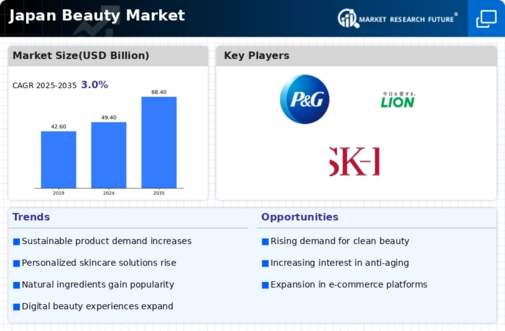Market Growth Projections
Growing Male Grooming Segment
The Global Japan Beauty Market Industry is witnessing a surge in the male grooming segment, reflecting changing societal norms and increasing acceptance of beauty and personal care among men. This shift is characterized by a growing demand for skincare, haircare, and grooming products tailored specifically for male consumers. Brands are responding by launching targeted marketing campaigns and product lines that cater to this demographic. As a result, the male grooming market is anticipated to expand significantly, contributing to the overall market growth and diversifying the consumer base within the beauty industry.
Emergence of E-commerce Platforms
The rise of e-commerce platforms has transformed the retail landscape of the Global Japan Beauty Market Industry. With the convenience of online shopping, consumers are increasingly turning to digital channels for their beauty purchases. E-commerce allows brands to reach a broader audience, offering a diverse range of products and competitive pricing. The ongoing investment in digital marketing strategies and user-friendly interfaces enhances the online shopping experience, driving sales growth. As e-commerce continues to gain traction, it is expected to play a pivotal role in shaping the future of the beauty market, particularly in urban areas.
Rising Demand for Natural Ingredients
The Global Japan Beauty Market Industry experiences a notable shift towards natural and organic ingredients, driven by consumer awareness regarding health and environmental sustainability. As consumers increasingly seek products free from harmful chemicals, brands are adapting their formulations to include plant-based and organic components. This trend is reflected in the growing sales of natural beauty products, which are projected to contribute significantly to the overall market value, expected to reach 235.94 USD Billion in 2024. Companies are investing in sustainable sourcing and eco-friendly packaging, aligning with the preferences of environmentally conscious consumers.
Technological Advancements in Beauty Products
Technological innovation plays a crucial role in the Global Japan Beauty Market Industry, enhancing product efficacy and consumer experience. The integration of advanced technologies such as artificial intelligence and augmented reality in beauty applications allows consumers to personalize their beauty routines. For instance, virtual try-on features enable users to visualize products before purchase, increasing customer engagement and satisfaction. As the market evolves, these technologies are likely to drive growth, contributing to a projected CAGR of 7.84% from 2025 to 2035, ultimately expanding the market size to 541.32 USD Billion by 2035.
Influence of Social Media and Beauty Influencers
Social media platforms significantly impact consumer behavior within the Global Japan Beauty Market Industry. The rise of beauty influencers and content creators has transformed how brands market their products, with platforms like Instagram and TikTok serving as vital channels for product promotion. Influencers often showcase product effectiveness through tutorials and reviews, creating a direct connection with their audience. This trend not only boosts brand visibility but also drives sales, as consumers are more likely to purchase products endorsed by trusted figures. The ongoing evolution of social media marketing strategies is expected to further enhance market growth.













